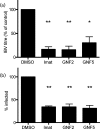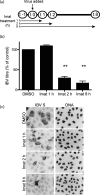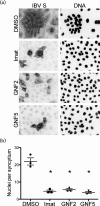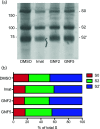Coronavirus S protein-induced fusion is blocked prior to hemifusion by Abl kinase inhibitors
- PMID: 29557770
- PMCID: PMC6537626
- DOI: 10.1099/jgv.0.001047
Coronavirus S protein-induced fusion is blocked prior to hemifusion by Abl kinase inhibitors
Abstract
Enveloped viruses gain entry into host cells by fusing with cellular membranes, a step that is required for virus replication. Coronaviruses, including the severe acute respiratory syndrome coronavirus (SARS-CoV), Middle East respiratory syndrome coronavirus (MERS-CoV) and infectious bronchitis virus (IBV), fuse at the plasma membrane or use receptor-mediated endocytosis and fuse with endosomes, depending on the cell or tissue type. The virus spike (S) protein mediates fusion with the host cell membrane. We have shown previously that an Abelson (Abl) kinase inhibitor, imatinib, significantly reduces SARS-CoV and MERS-CoV viral titres and prevents endosomal entry by HIV SARS S and MERS S pseudotyped virions. SARS-CoV and MERS-CoV are classified as BSL-3 viruses, which makes experimentation into the cellular mechanisms involved in infection more challenging. Here, we use IBV, a BSL-2 virus, as a model for studying the role of Abl kinase activity during coronavirus infection. We found that imatinib and two specific Abl kinase inhibitors, GNF2 and GNF5, reduce IBV titres by blocking the first round of virus infection. Additionally, all three drugs prevented IBV S-induced syncytia formation prior to the hemifusion step. Our results indicate that membrane fusion (both virus-cell and cell-cell) is blocked in the presence of Abl kinase inhibitors. Studying the effects of Abl kinase inhibitors on IBV will be useful in identifying the host cell pathways required for coronavirus infection. This will provide an insight into possible therapeutic targets to treat infections by current as well as newly emerging coronaviruses.
Keywords: Abl kinase; Abl1; Abl2; GNF2; GNF5; IBV; MERS-CoV; SARS-CoV; cell-cell fusion; coronavirus; imatinib; virus-cell fusion.
Conflict of interest statement
The authors declare that there are no conflicts of interest.
Figures







References
-
- Mingo RM, Simmons JA, Shoemaker CJ, Nelson EA, Schornberg KL, et al. Ebola virus and severe acute respiratory syndrome coronavirus display late cell entry kinetics: evidence that transport to NPC1+ endolysosomes is a rate-defining step. J Virol. 2015;89:2931–2943. doi: 10.1128/JVI.03398-14. - DOI - PMC - PubMed
Publication types
MeSH terms
Substances
Grants and funding
LinkOut - more resources
Full Text Sources
Other Literature Sources
Miscellaneous

